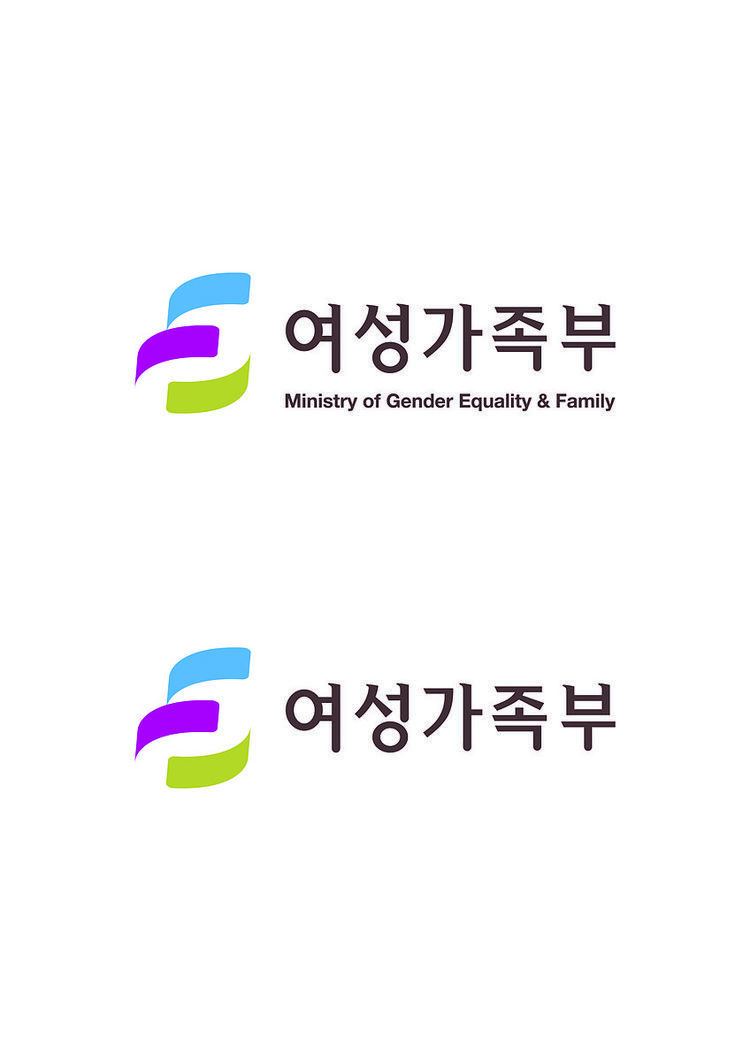 | ||
Formed January 29, 2001 (2001-01-29) Preceding agencies Ministry for Health, Welfare and Family AffairsMinistry of Gender EqualityMinistry of Political AffairsThe Presidential Commission of Women's Affairs Motto A society where all family members are happy / An equal society sharing together. Annual budget 302,570,000,000 Won (284,718,067 US Dollars) | ||
The Ministry of Gender Equality and Family (Hangul: 여성가족부; Hanja: 女性家族部, abbreviated to MOGEF) or the Ministry of Gender Equality (여성부, 女性部) is a cabinet-level division of the government of South Korea. It was created on February 28, 1998 as the Presidential Commission on Women's Affairs. The current Ministry was formed on January 29, 2001.
Contents
Origins
Since the establishment of the Government of South Korea on August 1948, the Ministry of Social Issues (사회부 ;社會部) handled discrimination against women until the department's merge in 1955. Afterwards, the Ministry of Social Issues merged with the Ministry of Health (보건부) to become the Ministry of Social Issues and Health (보건사회부). In 1994, the Ministry of Social Issues and Health became the Ministry of Health and Welfare (보건복지부); consequently, it began to take address discrimination against women. However, the ministries were criticized for the lack of advancement for women's social position and the lack of enforcement of its policies.
Specific policies addressing sexism began to be addressed with the establishment of the Department heading state affairs (정무장관실) on February 25, 1998. On February 28, 1998, the Presidential Commission on Women's Affairs (여성특별위원회) was formed under President Kim Dae-jung. On July 23, 1999, the Law forbidding and regulating sexual discrimination (남녀차별 금지 및 구제에 관한 법률) was created. However, the criticism concerning the lack of advancement in women's social position continued, and the Ministry of Gender Equality (여성부) was formed as a response on January 29, 2001. It was transferred following responsibilities: protecting the victims of domestic violence and sexual violence; prevention of prostitution; overseeing women's occupations from the Ministry of Health and Welfare.
Developments
On June 12, 2004, the ministry received the responsibilities of overseeing developments of infants from the Ministry of Health and Welfare. On June 23, 2005, the ministry reorganized to become the Ministry of Gender Equality and Family (여성가족부) in order for a more cohesive creation and enforcement of policies. On February 29, 2008, the ministry was changed back to the Ministry of Gender Equality while transferring the responsibilities of overseeing families and child care to the Ministry of Health and Welfare, which had become the Ministry for Health, Welfare and Family Affairs. On March 19, 2010, the Ministry was re-reorganized to become the Ministry of Gender Equality and Family while assuming back the responsibilities of overseeing teenagers, and families.
Objectives
According to the Official Ministry of Gender Equality and Family English website, the objectives of the ministry are:
Functions
According to the Official Ministry of Gender Equality and Family English website, the functions of the ministry are:
Sub-Organization
The Ministry is headed by a cabinet minister, and is organized with a Vice Minister who acts as a policy adviser to the minister and a Spokesperson. The Vice Minister controls the following divisions: the Management Supporting Division; Planning & Coordination Office; Women's Policy Bureau; Youth & Family Policy Office; Women & Youth Rights Promotion Bureau. The Spokesperson is in charge of the Public Relations Division.
Ministers
Controversy
MOGEF has been historically criticized for the involvement of the word Women (여성) in its name, which had led to charges of taking a side in the issue of gender inequality and reverse discrimination. The ministry has been involved in several controversies, which has led to a movement calling for its abolishment in 2006, 2008, and 2013.
On 2006, the MOGEF established a policy to pay men not to hire prostitutes on men's New Year's Day parties. Men were told to sign up on the website with their national identification number, and the total budget was 3,600,000 Won (3,175 US Dollars). This led to a signing movement to abolish the ministry.
On November 2011, the ministry enforced a System of forced shutdown of teenage gaming (청소년 게임 강제 셧다운제도), which has been involved in heavy controversy. The law has been criticized as being ineffective, encouraging teenagers to commit the crime of using their parents' resident registration number, and restricting the production of domestic games.
